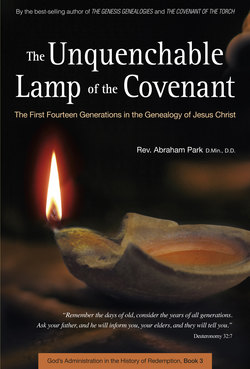Читать книгу The Unquenchable Lamp of the Covenant - Abraham Park - Страница 19
На сайте Литреса книга снята с продажи.
ОглавлениеWhile Genesis—the first book of the Old Testament—opens with the creation account of the heavens and the earth, Matthew—the first book of the New Testament—opens with the genealogy of Jesus Christ who came to this world to save fallen mankind. The first gateway through which the New Testament introduces the coming of Jesus Christ is the “genealogy.”
Generally speaking, a genealogy is a record of a family tree that records physical blood lineage. It is recorded for the purpose of conveying legal rights, verifying the purity of an ethnic heritage, and/or to boast of the achievements of one’s ancestors. In order to improve their own genealogies, people have not shied away from “beautifying” them by deleting shameful pasts and highlighting proud achievements. The nation of Korea has about 260 family names and puts great importance on genealogies to the extent that it can almost claim that the concept of genealogy originated from Korea. People used to guard the books of their genealogies with their lives, even if their house was on fire! It was the greatest disgrace to be obliterated from the genealogy of the family. In the case of pairing of marriages, the genealogy of the prospective spouse is scrutinized also.
The genealogies of the Jews have been well preserved even through tumultuous times and many wars (1 Chr 1–9). Land inheritance, birth order, as well as social position and status were all determined according to the genealogies (1 Chr 5:1–3; Num 3:10; 26:55; 33:54).
After returning from the Babylonian exile, those who asserted priestly rights had to prove that they were descendants in the priestly lineage through their genealogy. If their genealogy was uncertain, those people were forbidden from performing priestly duties (Ezra 2:61–63; Neh 7:63–64). Sons of three families among those who returned from the Babylonian exile—the sons of Habaiah, the sons of Hakkoz, and the sons of Barzillai—could not perform priestly duties because they could not prove their genealogical ancestries (Ezra 2:61). There were also sons from three families who were not able to provide evidence that their fathers’ households and their descendants were from Israel: the sons of Delaiah, the sons of Tobiah, and the sons of Nekoda—a total of 652 people (Ezra 2:59–60). One had to know his or her genealogy in order to be registered during the New Testament times (Luke 2:1–4). Because the Israelites valued their lineages, they would call a person specifically by mentioning the name of his or her father, grandfather or other direct or collateral relatives (Num 27:1; Josh 17:1; Zeph 1:1; 1 Sam 1:1; 1 Chr 4:37).
A genealogy not only contains the family’s roots, but also the history of various events and stories that took place in different times and places. At the same time, it serves as a firm foundation for future generations and the hope for their future. The genealogy is very important because it is the definitive proof that verifies and justifies the identity and social position of an individual.
Therefore, the genealogies in Matthew or Luke initially serve as conclusive evidence of the historicity of the birth of Jesus Christ of Nazareth and the proof of his identity. Jesus was a Jew by birth and an actual person in history, who was known to the people as the son of Mary and Joseph of Bethlehem of Judea (Luke 3:23). In essence, however, he was God the Son, the promised Messiah of the Old Testament, the one who was preordained from eternity according to God’s grand plan for the salvation of mankind.
The genealogy of Jesus Christ is the very core of the entire history of redemption. It is a vivid panorama of redemptive history, which awakens us to God’s faithfulness in continuing the genealogy and to His zeal in working without resting until the final fulfillment of the covenant.
